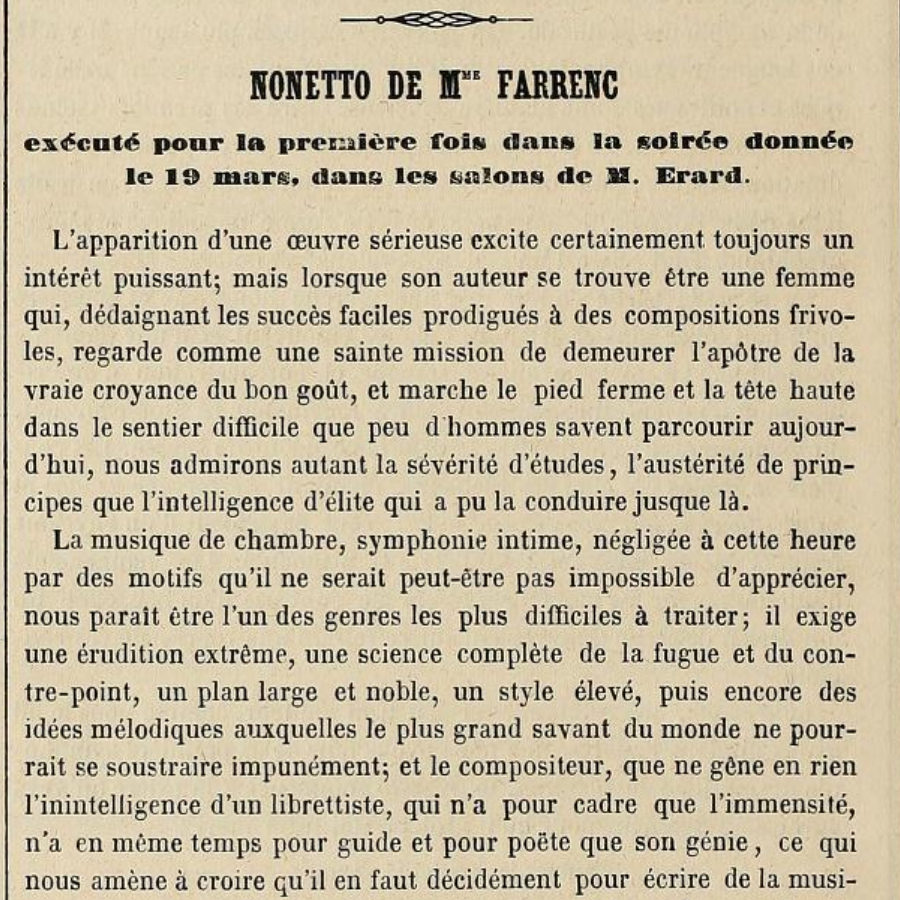
Horn player and guest artist Pierre-Antoine Tremblay shared a copy of a review of the premiere of Farrenc’s Nonet, published March 31, 1850, in the Revue et gazette musicale de Paris.
Our own Charlotte Nediger, harpsichordist and Tafelmusik librarian, has translated this to English.
On October 28 and 29, 2022, we will perform Farrenc’s Nonet in E-flat Major, op. 38—and we hope it garners the same critical excitement now as it did in 1850!
Read the review in full below.
NONETTO by Mme FARRENC
Performed for the first time at the soirée given 19 March in the salons of M. Erard
The appearance of a serious work certainly always excites a powerful interest; but when its author happens to be a woman who, disdaining the easy successes lavished on frivolous compositions, regards it as a sacred mission to remain the apostle of true belief in good taste, and with firm footing and head held high, walks the difficult path that few men know how to traverse today, we admire as much the rigour of her studies and the austerity of her principles as we do the superior intelligence that has brought her this far.
Chamber music, the intimate symphony, neglected at this time for reasons that are perhaps not impossible to appreciate, seems to us to be one of the most difficult genres to undertake. It requires extreme erudition, a complete knowledge of fugue and counterpoint, a broad and noble plan, an elevated style, as well as melodic ideas from which the greatest scholar in the world could not escape with impunity. The composer, unhindered in any way by a librettist’s lack of intelligence, has only the immensity of the world as a framework, and only their own genius as guide and muse. This leads us to believe that it is very demanding to write symphonic music, and to suggest that it has not yet been fully demonstrated to us, but rather has been but a useless appetizer to other compositions.
We confess to being picky about this type of music as demonstrated by the greatest masters. And yet Mme Farrenc’s Nonetto pleased us very much the other evening. The first movement opens in a style that is perfectly clear and limpid; the second part is infinitely remarkable, the details and development are masterfully handled. The Andante with variations is very pleasing to us; the turn of the melody is pure and easy, and the instruments seem to us to be perfectly disposed. The Scherzo is a complete piece, with a cheerful mien and a picturesque effect. The Finale, written in a concise manner, holds one’s interest throughout and worthily crowns this important work, which would scarcely increase the [high] esteem in which its author is [already] held, but which nevertheless shows us a real progress, a more vigorous, more virile touch, of splendour and brilliance.
The evening began with a charming trio by the same author, and ended with the piano and violin sonata, the effect of which was prodigious, especially in the Andante, which the great young violinist Joachim played with a noble and profound passion that drew the audience to him. Mme Farrenc must have been happy with the great success of this evening, which was proof of the public’s enthusiasm for the rigorous and pure works which we regretfully hear only too rarely.
Mme Farrenc held sway at the piano as a true composer; Messrs Dorus, Yerroust frères, Leroy, Rousselot, Joachim, Blanc, Lebouc and Gouffé overwhelmed with their talents. Despite the crowd, despite the stifling heat, the evening went on very late, Joachim having kindly ended it with Sebastian Bach’s famous Chaconne, which the author himself may have never heard performed in such an impressive manner.
Th. Wartel
Revue et Gazette Musicale de Paris: March 31, 1850
Translation by Charlotte Nediger
Don’t miss Trailblazers: Mendelssohn & Farrenc on October 28 and 29, 2022: tickets at tafelmusik.org/trailblazers
